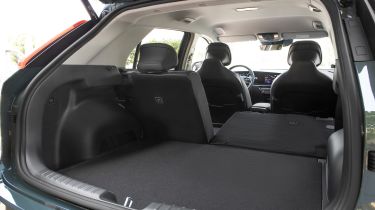Kia Niro SUV - Practicality & boot space
An increase in overall size makes the Niro competitive with rivals
The Niro has grown slightly in size; it’s now 65mm longer, 20mm taller and 10mm wider, with a 20mm longer wheelbase (the distance between the front and rear wheels). This is good news for practicality, with a small boost in passenger and luggage space, without making the Niro feel noticeably bigger to drive or more difficult to park.
Kia Niro interior space & storage
The Niro might be something of a cross between a hatchback and an SUV, but the tall roofline and longer wheelbase add up to a set of rear seats that tall passengers should feel happy in, while also providing plenty of space for child seats. The rear seats in the EV aren’t quite as comfy, however, because the underfloor battery raises the floor somewhat, causing long-legged passengers to sit with their knees slightly raised.
Boot space
The boot has also increased in size, with up to 451 litres available behind the back seats in the Niro Hybrid. This is less than the maximum space found in the Renault Captur E-Tech Hybrid, but that car has a sliding rear bench, and with this in its rearmost position, the boot shrinks to just 379 litres.
Thanks to its low-slung battery, the Niro EV actually has the biggest boot of the trio, with 475 litres. Typically, the electric version of a car tends to have the smallest boot, so this will come as a pleasant surprise to those looking to make the switch to a fully-electric model. There’s also a small ‘frunk’ under the bonnet, but measuring just 20 litres, it’s best suited to keeping the charging cables tidy and out of the way.
It’s the Niro PHEV that has the smallest boot, shrinking to just 348 litres because of the positioning of the 11.1kWh battery.
Which Is Best?
Cheapest
- Name1.6 GDi 127 Hybrid 2 Nav 5dr DCT
- Gearbox typeAuto
- RRP£30,085
Most Economical
- Name1.6 GDi 168 PHEV 2 5dr DCT
- Gearbox typeAuto
- RRP£35,325
Fastest
- Name1.6 GDi 168 PHEV 2 5dr DCT
- Gearbox typeAuto
- RRP£35,325















